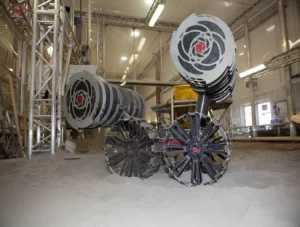NASA is actively testing a novel robot designed for mining lunar regolith, or Moon dust, at the Kennedy Space Center in Florida. These experiments are conducted in specialized labs that simulate lunar conditions, complete with large landscape formations, to accurately mimic the physical and mechanical properties of lunar rock and terrain.
The robot, named RASSOR (Regolith Advanced Surface Systems Operations Robot), is an unconventional rover featuring drum buckets. These rotating drums allow it to efficiently extract and crush significant volumes of lunar rock, collecting it for various purposes. This capability is crucial for constructing structures on the Moon and gathering materials for processing. Specifically, the plan is to extract valuable resources from lunar regolith, including hydrogen for rocket fuel, oxygen and water to support crewed missions, and metals for construction.

The recent tests primarily aimed to demonstrate RASSOR’s ability to effectively excavate and transport lunar rock. Similar drum bucket mechanisms are slated for use in NASA’s IPEx (In-Situ Resource Utilization Pilot Excavator) mission. These bucket drums will be adapted in size based on the specific tasks and the payload capacity of the lunar delivery vehicles.
This specialized rover will be operated remotely. Its design prioritizes lightweight components, recognizing the high cost of transporting cargo to the Moon. The project’s creators envision applying this technology to mining operations on Earth and even Mars, requiring some system modernizations for the latter. The robot’s symmetrical design enables movement in any direction, and a unique suspension system ensures excellent stability and the capability to navigate challenging, uneven terrain.
This initiative follows previous reports of NASA’s plans to send an instrument to the Moon to search for helium-3.
